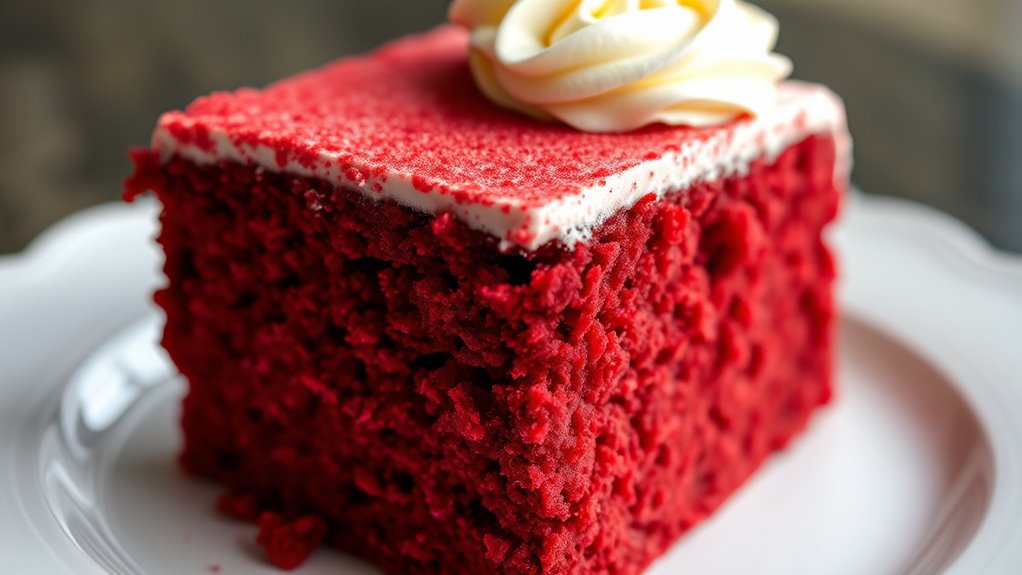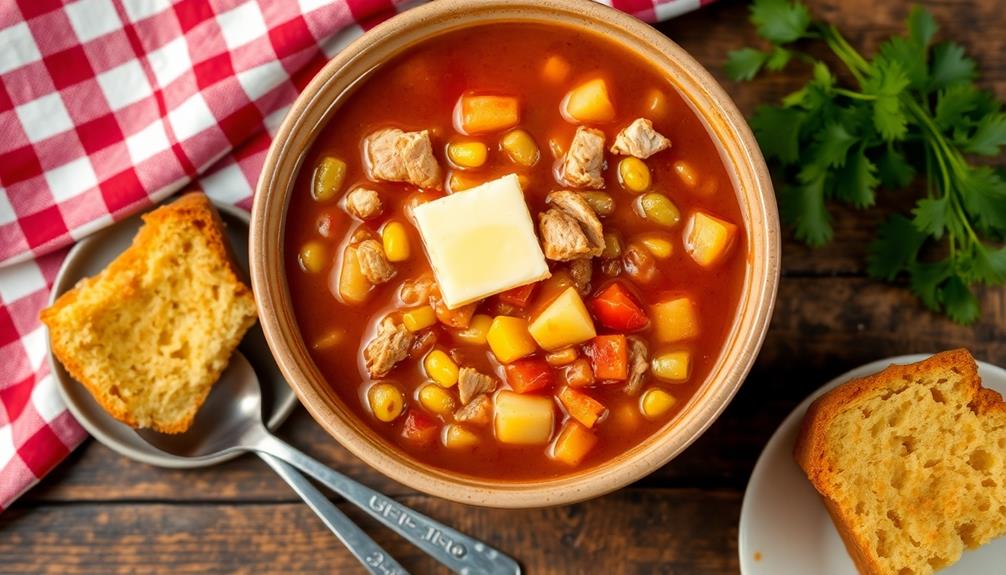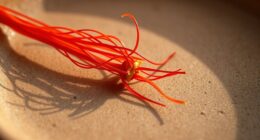To make a moist Southern red velvet cake, you need to understand how vinegar (acidic) reacts with baking soda (base) to produce carbon dioxide, which makes the cake rise and stay fluffy. This acid-base interaction also enhances the cake’s vibrant color by intensifying the red dye. Additionally, the acidity tenderizes gluten, resulting in that soft, velvety crumb. Keep exploring how these simple ingredients work together for perfect results every time.
Key Takeaways
- Vinegar’s acidity reacts with baking soda to produce carbon dioxide, creating a moist, fluffy crumb essential to red velvet’s texture.
- Acidic conditions from vinegar enhance red food coloring’s vibrancy, resulting in the cake’s rich, deep hue.
- The acid-base interaction softens gluten, leading to a tender, velvety crumb characteristic of southern red velvet cake.
- Proper balance of vinegar and food coloring ensures consistent color depth and moistness in each bake.
- Automation and precise ingredient control optimize these chemical reactions, ensuring moistness and vibrant appearance.

Have you ever wondered what makes red velvet cake so irresistibly rich and velvety? The secret lies in a delicate balance of ingredients and the chemistry behind them. One key factor is the use of food coloring, which gives the cake its signature deep red hue. But it’s not just the color that captures your eye; it’s also the way the ingredients interact on a chemical level that creates that smooth, moist texture you love. Understanding the food coloring and vinegar interaction helps reveal why this cake stands out from other desserts.
Many bakers use liquid or gel food coloring to achieve the vibrant red shade. When combined with the batter, the coloring disperses evenly, but it’s the reaction with other ingredients that enhances the color’s intensity. Historically, bakers relied on artificial dyes, but today, some prefer natural alternatives. Regardless of the type, the food coloring’s role is more than aesthetic—it’s part of a chemical interaction that affects how the cake’s crumb develops. The acidity of the batter influences how the color appears, especially when combined with vinegar.
Liquid or gel food coloring enhances red velvet’s vibrant hue through chemical reactions influenced by acidity.
Vinegar plays a crucial role in the chemistry of red velvet cake. It’s an acid that reacts with baking soda, which is a base, creating carbon dioxide bubbles that help the cake rise. But vinegar’s interaction with the food coloring is also vital for achieving that perfect red. When you add vinegar to the batter, it slightly acidifies the mixture. This acid environment intensifies the red hue of the food coloring, making it more vibrant and deep. Without enough acidity, the color might turn out dull or pinkish instead of the rich red that defines this cake.
This acid-base chemistry doesn’t just affect the color; it also influences the cake’s texture. The vinegar’s acidity breaks down gluten strands, resulting in a softer, more tender crumb. The carbon dioxide produced during baking, thanks to the vinegar and baking soda reaction, creates a moist, fluffy interior. The interaction between food coloring and vinegar is subtle but essential—without it, your red velvet might lack that signature depth of color and velvety mouthfeel. Interestingly, the use of automation in baking processes is beginning to influence how such chemical interactions are managed and optimized in commercial production.
In essence, the secret to that stunning red and moist texture comes down to understanding how food coloring and vinegar interact. This chemistry ensures your cake not only looks stunning but also delivers that melt-in-your-mouth experience you’re craving. Recognizing the importance of color accuracy and precise ingredient interactions can help bakers perfect their recipes. So, the next time you bake a red velvet cake, pay attention to these tiny but powerful chemical interactions—they’re what make this dessert truly special.
Frequently Asked Questions
What Is the History Behind Red Velvet Cake’s Popularity?
You might wonder about red velvet cake’s history origins and how it gained fame. Its popularity grew in the early 20th century, especially in the Southern U.S., thanks to its unique color and texture. As recipes spread through cookbooks and media, it became a cultural symbol of elegance and celebration. Today, its widespread appeal continues, blending tradition with modern twists that keep the cake a favorite across many regions.
How Does Altitude Affect Red Velvet Cake Baking?
When baking red velvet cake at high altitudes, you need to make altitude adjustments to make certain it turns out perfect. You should increase the oven temperature slightly to compensate for rapid rising, and reduce the amount of leavening agents to prevent overflowing. Additionally, you might need to add a bit more liquid to keep the batter moist. These tweaks help your cake stay moist and fluffy despite the altitude challenges.
Can Red Velvet Cake Be Made Gluten-Free?
You can make red velvet cake gluten-free by swapping traditional flour with gluten alternatives like almond, coconut, or gluten-free all-purpose blends. Just be mindful of cross-contamination risks, especially if you’re using packaged ingredients. Always check labels and use dedicated utensils. With the right substitutes and precautions, you’ll enjoy a moist, vibrant red velvet cake that’s safe for gluten-sensitive diets.
What Are Common Mistakes to Avoid When Baking Red Velvet Cake?
Ever notice your red velvet cake isn’t quite right? You might be making common mistakes like incorrect ingredient substitution or setting the oven temperature too high or low. To avoid this, measure ingredients precisely, especially cocoa and vinegar, and follow the recipe closely. Keep the oven at the recommended temperature to ensure even baking. Small errors like these can affect texture, color, and moisture—so pay attention for perfect, moist results.
How Can I Customize Red Velvet Cake for Dietary Restrictions?
To customize your red velvet cake for dietary restrictions, you can swap sugar with sugar alternatives like erythritol or stevia, and use dairy substitutes such as almond or coconut milk. These adjustments let you enjoy a delicious cake without compromising flavor. Be sure to also choose egg replacements if needed, and adjust baking times accordingly. This way, you create a tasty, inclusive dessert perfect for everyone.
Conclusion
Now that you know the science behind red velvet cake’s moist texture and vibrant color, you can appreciate its surprising complexity. Just like the delicate balance of acid and base in baking, your experience with this cake is a perfect blend of science and delight. So, next time you bite into its tender crumb, remember—it’s not just a dessert, but a delicious harmony of chemistry and craft. Enjoy every moist, flavorful moment.










